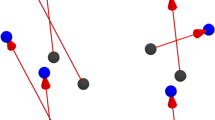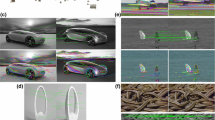Abstract
When incorrect values for the extrinsic and intrinsic parameters of the two cameras of a stereo rig are used in the reconstruction of a three-dimensional scene from image correspondences, the resulting reconstruction is distorted in a systematic way. We show here that the transformation between the true scene structure and its distorted reconstruction is a quadratic Cremona transformation — a rational transformation which is one-to-one almost everywhere, but which does not in general preserve collinearity.
We study the distortion of points in the fixation plane on a global, qualitative, level, and on a local, quantitative level. Both global and local viewpoints provide evidence of severe non-linear distortions in the vicinity of the camera centers, thereby indicating that their consideration is of particularly high relevance for near regions of the stereo rig. This is consistent with experimental evidence from psychophysics, which shows that distortions in the near range can not be adequately described by linear transformations.
Our distortion framework describes and enables the analysis of situations where insufficient information is available to compute even a weak calibration of a stereo rig. It also makes possible a thorough error analysis of systematic errors in computing structure from motion.
Preview
Unable to display preview. Download preview PDF.
Similar content being viewed by others
References
G. Baratoff, “Distortion of Stereoscopic Visual Space”, Tech. Rep. CAR-TR-861, Center for Automation Research, Univ. of Maryland, College Park, USA, May 1997.
L. Cheong and Y. Aloimonos, “Iso-distortion contours and Egomotion Estimation,” in Proc. Int. Symposium on Computer Vision, pp. 55–60, 1995.
L. Cheong, C. Fermüller and Y. Aloimonos, “Interaction Between 3D Shape and Motion: Theory and Applications,” Technical Report CAR-TR-773, Center for Automation Research, Univ. of Maryland, College Park, USA, June 1996.
O. Faugeras, “What can be seen in three dimensions with an uncalibrated stereo rig,” in Proc. 2nd European Conf. on Computer Vision, G. Sandini, ed., Vol. 538 of Lecture Notes in Computer Science (Springer Verlag, Berlin), pp. 563–578, 1992.
C. Fermüller, L. Cheong and Y. Aloimonos, “Explaining Human Visual Space Distortion,” Technical Report CAR-TR-833, Center for Automation Research, Univ. of Maryland, College Park, USA, July 1996.
S. Maybank, “Theory of Reconstruction from Image Motion”, Springer-Verlag, Berlin, 1993.
C. C. Slama and C. Theurer and S. W. Henriksen, “Manual of Photogrammetry”, Am. Soc. of Photogrammetry, 1980.
J.G. Semple and L. Roth, Introduction to Algebraic Geometry, Oxford, 1949.
J. S. Tittle, J. T. Todd, V. J. Perotti, and J. F. Norman, “Systematic Distortion of Perceived Three-Dimensional Structure From Motion and Binocular Stereopsis”, J. of Experimental Psychology, vol. 21 (1995), no. 3, pp. 663–678.
Author information
Authors and Affiliations
Editor information
Rights and permissions
Copyright information
© 1997 Springer-Verlag Berlin Heidelberg
About this paper
Cite this paper
Baratoff, G. (1997). Distortions of stereoscopic visual space and quadratic Cremona transformations. In: Sommer, G., Daniilidis, K., Pauli, J. (eds) Computer Analysis of Images and Patterns. CAIP 1997. Lecture Notes in Computer Science, vol 1296. Springer, Berlin, Heidelberg. https://doi.org/10.1007/3-540-63460-6_123
Download citation
DOI: https://doi.org/10.1007/3-540-63460-6_123
Published:
Publisher Name: Springer, Berlin, Heidelberg
Print ISBN: 978-3-540-63460-7
Online ISBN: 978-3-540-69556-1
eBook Packages: Springer Book Archive




